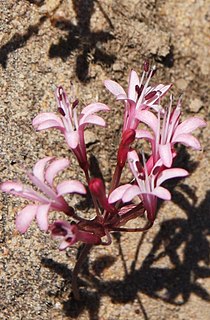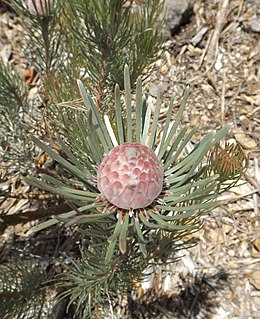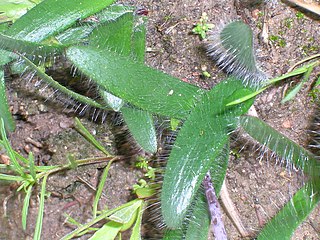Palinurus barbarae is a species of spiny lobster described in 2006, which was found by fishermen working the waters above the Walters Shoals, a series of submerged mountains 700 kilometres (430 mi) south of Madagascar. The animal weighs 4 kilograms (8.8 lb) and reaches up to 40 centimetres (16 in) long excluding the long antennae, and is similar to P. delagoae, found off South Africa, from which it may be differentiated by a number of characters including the larger number of spines. There are fears that the species, which lives in an area outside any country's jurisdiction, may now be exploited, or that it has already been brought near to extinction by overfishing.
Haplochromis barbarae is a species of cichlid endemic to Lake Victoria where it may now be extinct. This species can reach a length of 10.6 centimetres (4.2 in) SL. The honors Barbara Williams who illustrated many of Greenwood's papers.
Passiflora sanctae-barbarae is a species of plant in the family Passifloraceae. It is endemic to Ecuador.
Sphaeradenia sanctae-barbarae is a species of plant in the Cyclanthaceae family. It is endemic to Ecuador. Its natural habitat is subtropical or tropical moist montane forests.

Strumaria is a genus of African plants in Amaryllis family, subfamily Amaryllidoideae. The genus is known in nature only from South Africa, Lesotho and Namibia. Species flower in the autumn and are cultivated as ornamental bulbous plants.
Strumaria hardyana is a species of plant that is endemic to Namibia. Its natural habitats are subtropical or tropical dry shrubland and rocky areas.
Strumaria phonolithica is a species of plant that is endemic to Namibia. Its natural habitats are subtropical or tropical dry shrubland and rocky areas.

Leucadendron album is a species of flowering plant in the family Proteaceae that grows in South Africa.
Aloeides barbarae, the Barbara's copper, is a butterfly of the family Lycaenidae. It is found in South Africa, where it is only known from montane grassland on one hill top between Fairview and the Sheba Mines in Mpumalanga.

Hessea is a genus of bulb-forming plants in the Amaryllis family native to Namibia and South Africa. The genus name commemorates C. H. F. Hesse (1772–1832), who resided in Cape Town from 1800 to 1817.
Strumaria unguiculata is a plant species endemic to Western Cape Province in South Africa.

Leucadendron laureolum, common names golden conebush and laurel leaf conebush, is a species of plant in the family Proteaceae. It is endemic to South Africa and also cultivated. It is a large bush that turns bright yellow in the winter flowering season.

Lestoidea barbarae is a species of Australian damselfly in the family Lestoideidae, commonly known as a large bluestreak. It has only been recorded from the vicinity of Wooroonooran National Park, in north-east Queensland, where it inhabits streams in rainforest.

Dierdré "Dee" Anne Snijman is a South African botanist and plant taxonomist who is notable for studying and writing extensively on bulbs. She has described over 120 species and has written comprehensive works on South African flora. She received the 1997 Herbert Medal from the International Bulb Society for her research on Amaryllis.
Strumaria spiralis is a species of flowering plant belonging to the family Amaryllidaceae.
Leucadendron cadens, the Witteberg sunbush, is a flower-bearing shrub that belongs to the genus Leucadendron and forms part of the fynbos. The plant is native to the Western Cape, South Africa. The plant is rare.

Leucadendron meridianum, the limestone conebush, is a flower-bearing shrub belonging to the genus Leucadendron and forms part of the fynbos. The plant is native to the Western Cape, South Africa.

Serruria furcellata, the Kraaifontein spiderhead, is a flower-bearing shrub that belongs to the genus Serruria and forms part of the fynbos. The plant is native to the Western Cape, it has always been found at Brackenfell, Kraaifontein and Kuils River.

Strumaria chaplinii is a species of bulbous flowering plant in the family Amaryllidaceae, native to south-west Cape Provinces. It was first described in 1944 as Hessea chaplinii.









